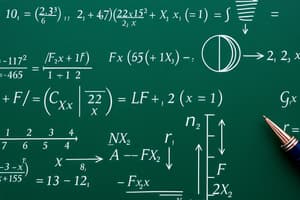Podcast
Questions and Answers
What branch of mathematics deals with the study of shapes, sizes, and positions of objects?
What branch of mathematics deals with the study of shapes, sizes, and positions of objects?
- Geometry (correct)
- Algebra
- Calculus
- Statistics
Which of the following is NOT a basic mathematical operation?
Which of the following is NOT a basic mathematical operation?
- Subtraction
- Addition
- Division
- Exponents (correct)
Which set of numbers includes all rational and irrational numbers?
Which set of numbers includes all rational and irrational numbers?
- Natural numbers
- Rational numbers
- Integers
- Real numbers (correct)
What does the symbol '∪' represent in set theory?
What does the symbol '∪' represent in set theory?
Which of these mathematical tools provides a visual representation of relationships between variables?
Which of these mathematical tools provides a visual representation of relationships between variables?
What is the square root of 25?
What is the square root of 25?
What type of number is 3.14?
What type of number is 3.14?
Flashcards are hidden until you start studying
Study Notes
Branches of Mathematics
• Arithmetic: The study of numbers and their operations (e.g., addition, subtraction, multiplication, division). • Algebra: The study of variables and their relationships, often expressed through the use of symbols, equations, and functions. • Geometry: The study of shapes, sizes, and positions of objects, including points, lines, angles, and solids. • Calculus: The study of change and motion, including limits, derivatives, and integrals. • Statistics: The study of the collection, analysis, and interpretation of data. • Topology: The study of the properties of shapes and spaces that are preserved under continuous deformations.
Mathematical Operations
• Basic Operations: + Addition (+) + Subtraction (-) + Multiplication (×) + Division (÷) • Exponents and Logarithms: + Exponents (e.g., 2^3) + Logarithms (e.g., log2(8)) • Roots: + Square root (√) + Cube root (³√)
Mathematical Concepts
• Numbers: + Natural numbers (1, 2, 3, ...) + Whole numbers (0, 1, 2, 3, ...) + Integers (...,-3, -2, -1, 0, 1, 2, 3, ...) + Rational numbers (fractions, e.g., 3/4) + Irrational numbers (e.g., π, e) + Real numbers (includes rational and irrational numbers) + Complex numbers (includes real and imaginary parts) • Sets: + Union (∪) + Intersection (∩) + Difference (-) + Complement (')
Mathematical Tools
• Graphs: Visual representations of relationships between variables. • Charts: Visual representations of data. • Tables: Organized displays of data. • Formulas: Mathematical expressions used to calculate values. • Theorems: Mathematical statements proven to be true.
Branches of Mathematics
- Arithmetic studies numbers and operations like addition, subtraction, multiplication, and division.
- Algebra involves variables, symbols, equations, and functions to express relationships.
- Geometry examines shapes, sizes, and positions of objects, including points, lines, angles, and solids.
- Calculus explores change and motion using limits, derivatives, and integrals.
- Statistics deals with collecting, analyzing, and interpreting data.
- Topology investigates properties of shapes and spaces under continuous deformations.
Mathematical Operations
- Basic operations include addition, subtraction, multiplication, and division.
- Exponents and logarithms involve expressions like 2^3 and log2(8).
- Roots include square root (√) and cube root (³√).
Mathematical Concepts
- Natural numbers start from 1 and increment by 1.
- Whole numbers begin with 0 and increment by 1.
- Integers include all whole numbers and their negatives.
- Rational numbers are fractions, such as 3/4.
- Irrational numbers cannot be expressed as fractions, like π and e.
- Real numbers encompass rational and irrational numbers.
- Complex numbers have real and imaginary parts.
- Sets can be combined using union (∪), intersected using intersection (∩), and have differences (-) and complements (').
Mathematical Tools
- Graphs visually represent relationships between variables.
- Charts display data in a visual format.
- Tables organize data in a structured display.
- Formulas are mathematical expressions used to calculate values.
- Theorems are mathematical statements proven to be true.
Studying That Suits You
Use AI to generate personalized quizzes and flashcards to suit your learning preferences.




